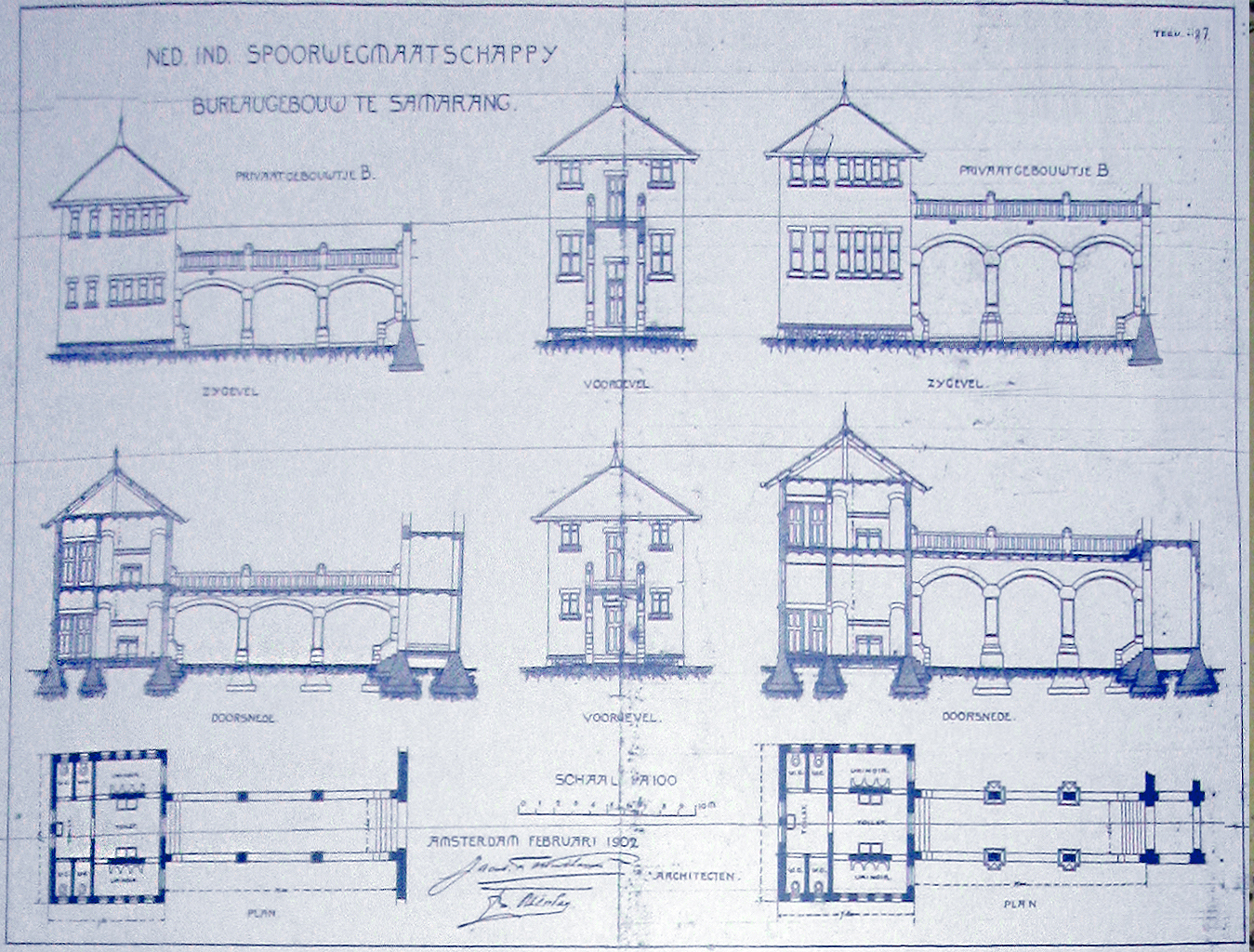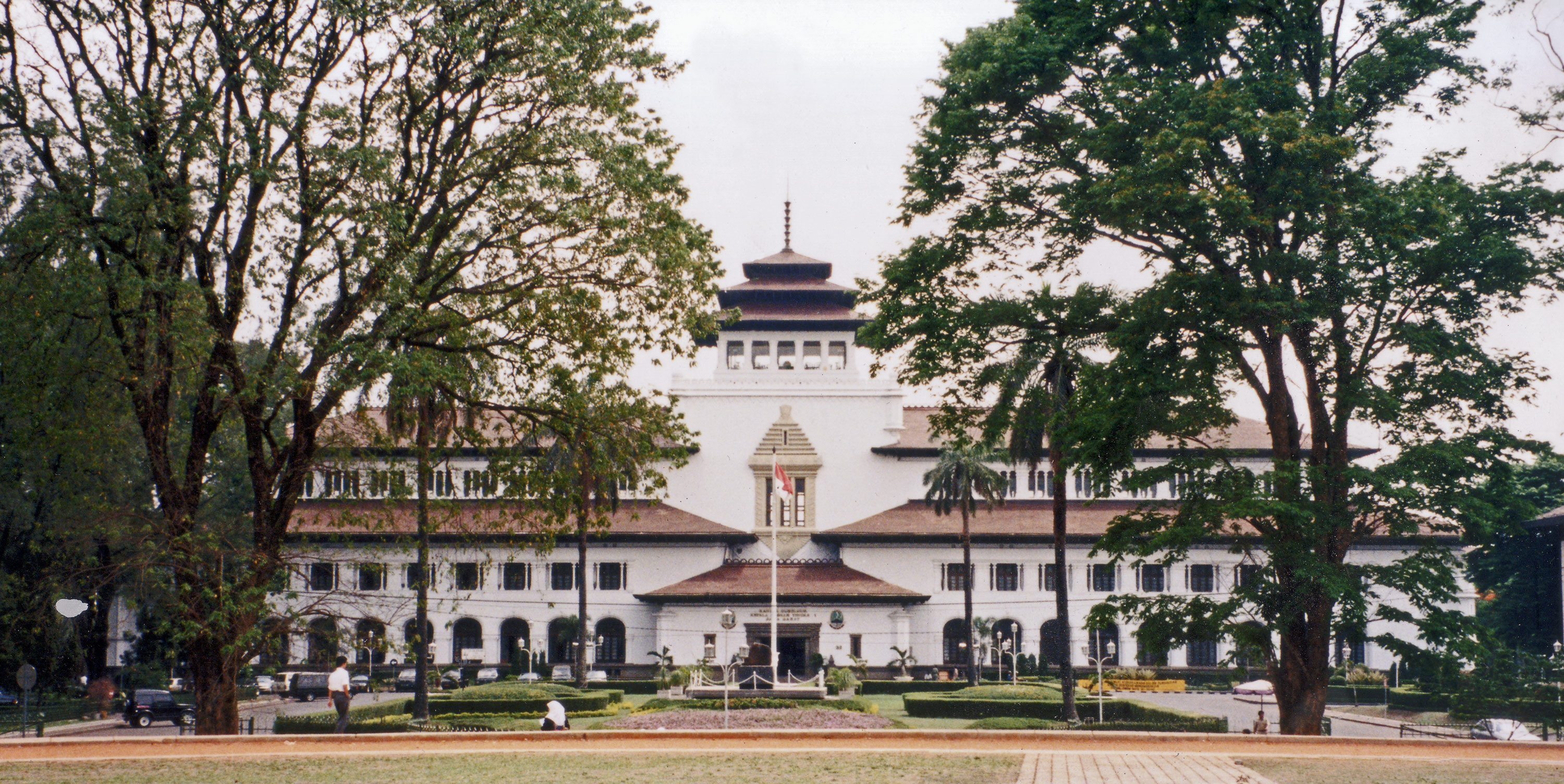|
Cosman Citroen
Cosman Citroen (26 August 1881 – 15 May 1935) was a Dutch architect. He designed buildings in the Dutch East Indies including the headquarters of the Dutch East Indies Railway Company. Early life Citroen was the son of Levie Citroen (born on November 12, 1855), a diamond cutter in Amsterdam, and Sara Levie Coltof (born on February 26, 1852). The family included six children. Career Citroen took an architectural education at the State Normal School in Amsterdam and obtained his degree for teacher MO engineering. For the next thirteen years (1902 to 1915) he worked in the architectural firm of J.F. Klinkhamer and B.J. Ouëndag. In 1907, he helped design of the NIS headquarters and worked as the company's bureau chief. In 1915 he left to move to the Dutch East Indies. In 1916, he made the first plans for a new town hall and designed the building for the Darmo Hospital. He was a member of several committees, such as the construction restrictions commission and the Archaeologic ... [...More Info...] [...Related Items...] OR: [Wikipedia] [Google] [Baidu] |
Amsterdam
Amsterdam ( , , , lit. ''The Dam on the River Amstel'') is the Capital of the Netherlands, capital and Municipalities of the Netherlands, most populous city of the Netherlands, with The Hague being the seat of government. It has a population of 907,976 within the city proper, 1,558,755 in the City Region of Amsterdam, urban area and 2,480,394 in the Amsterdam metropolitan area, metropolitan area. Located in the Provinces of the Netherlands, Dutch province of North Holland, Amsterdam is colloquially referred to as the "Venice of the North", for its large number of canals, now designated a World Heritage Site, UNESCO World Heritage Site. Amsterdam was founded at the mouth of the Amstel River that was dammed to control flooding; the city's name derives from the Amstel dam. Originally a small fishing village in the late 12th century, Amsterdam became a major world port during the Dutch Golden Age of the 17th century, when the Netherlands was an economic powerhouse. Amsterdam is th ... [...More Info...] [...Related Items...] OR: [Wikipedia] [Google] [Baidu] |
Surabaya
Surabaya ( jv, ꦱꦸꦫꦧꦪ or jv, ꦯꦹꦫꦨꦪ; ; ) is the capital city of the Provinces of Indonesia, Indonesian province of East Java and the List of Indonesian cities by population, second-largest city in Indonesia, after Jakarta. Located on the northeastern border of Java island, on the Madura Strait, it is one of the earliest port cities in Southeast Asia. According to the Government of Indonesia, National Development Planning Agency, Surabaya is one of the Regions of Indonesia#Development regions, four main central cities of Indonesia, alongside Jakarta, Medan, and Makassar. The city has a population of 2.87 million within its city limits at the 2020 census and 9.5 million in the extended Surabaya metropolitan area, making it the List of metropolitan areas in Indonesia, second-largest metropolitan area in Indonesia. The city was settled in the 10th century by the Janggala, Kingdom of Janggala, one of the two Javanese kingdoms that was formed in 1045 when ... [...More Info...] [...Related Items...] OR: [Wikipedia] [Google] [Baidu] |
Architect
An architect is a person who plans, designs and oversees the construction of buildings. To practice architecture means to provide services in connection with the design of buildings and the space within the site surrounding the buildings that have human occupancy or use as their principal purpose. Etymologically, the term architect derives from the Latin ''architectus'', which derives from the Greek (''arkhi-'', chief + ''tekton'', builder), i.e., chief builder. The professional requirements for architects vary from place to place. An architect's decisions affect public safety, and thus the architect must undergo specialized training consisting of advanced education and a ''practicum'' (or internship) for practical experience to earn a Occupational licensing, license to practice architecture. Practical, technical, and academic requirements for becoming an architect vary by jurisdiction, though the formal study of architecture in academic institutions has played a pivotal role in ... [...More Info...] [...Related Items...] OR: [Wikipedia] [Google] [Baidu] |
Lawang Sewu
''Lawang Sewu'' () is a former office building in Semarang, Central Java, Indonesia. It was a head office of the Dutch East Indies Railway Co. (Nederlandsch-Indische Spoorweg Maatschappij/NIS) and is owned by the national railway company Kereta Api Indonesia (KAI). Its predecessor, Djawatan Kereta Api, was seized every rail transport infrastructures and offices from Dutch occupation. Today the building is used as a museum and heritage railway gallery, currently operated by Heritage Unit of KAI and its subsidiary KAI Wisata. Etymology The Javanese word ''lawang sewu'' is a nickname for the building, which means "a thousand doors". The name comes from its design, with numerous doors and arcs. The building has about 600 large windows. Layout The complex consists of several buildings, two main ones named A and B and two smaller ones named C and D, on Pemuda Street. The L-shaped A building faces the Tugu Muda roundabout. There are two identical towers on A building, which were origin ... [...More Info...] [...Related Items...] OR: [Wikipedia] [Google] [Baidu] |
Dutch East Indies
The Dutch East Indies, also known as the Netherlands East Indies ( nl, Nederlands(ch)-Indië; ), was a Dutch colony consisting of what is now Indonesia. It was formed from the nationalised trading posts of the Dutch East India Company, which came under the administration of the Dutch government in 1800. During the 19th century, the Dutch possessions and hegemony expanded, reaching the greatest territorial extent in the early 20th century. The Dutch East Indies was one of the most valuable colonies under European rule, and contributed to Dutch global prominence in spice and cash crop trade in the 19th to early 20th centuries. The colonial social order was based on rigid racial and social structures with a Dutch elite living separate from but linked to their native subjects. The term ''Indonesia'' came into use for the geographical location after 1880. In the early 20th century, local intellectuals began developing the concept of Indonesia as a nation state, and set the stage ... [...More Info...] [...Related Items...] OR: [Wikipedia] [Google] [Baidu] |
Ketabang
Ketabang is an area of Genteng, Surabaya in East Java, Indonesia. The area was planned by Dutch architect Cosman Citroen Cosman Citroen (26 August 1881 – 15 May 1935) was a Dutch architect. He designed buildings in the Dutch East Indies including the headquarters of the Dutch East Indies Railway Company. Early life Citroen was the son of Levie Citroen (born on .... See also * Dutch architecture of Surabaya References Populated places in East Java Surabaya {{Indonesia-stub ... [...More Info...] [...Related Items...] OR: [Wikipedia] [Google] [Baidu] |
Colonial Architecture Of Surabaya
Colonial architecture in Surabaya (Dutch: Soerabaja) includes the legacy of neoclassical architecture and Dutch architecture built during the Dutch East Indies era. The old city in Surabaya is a tourist attraction but faces problems with the deterioration of older buildings. It includes Dutch architecture, has an Arab quarter and areas exhibiting Chinese influence. Jembatan Merah is an area known for its Dutch architecture. Cosman Citroen designed a city hall in 1916 and planned the area of Ketabang. Museum Bank Indonesia, Surabaya is located in the former Bank of Java branch building. The House of Sampoerna i s a museum devoted to the history of clove cigarette (kretek) manufacturing in Indonesia and is housed in a Dutch colonial building (originally an orphanage) dating to 1864.Lonely Planet Indonesia< ... [...More Info...] [...Related Items...] OR: [Wikipedia] [Google] [Baidu] |
Colonial Architecture Of Indonesia
The colonial architecture of Indonesia refers to the buildings that were created across Indonesia during the Dutch colonial period, during that time, this region was known as the Dutch East Indies. These types of colonial era structures are more prevalent in Java and Sumatra, as those islands were considered more economically significant during the Dutch imperial period. As a result of this, there is a large number of well preserved colonial era buildings that are still densely concentrated within Indonesian cities in Java and Sumatra to this day. In the rest of the archipelago, there is also a sizeable amount of old Dutch East India Company (VOC) era forts and warehouses that were built during the Dutch colonial period of Indonesia, particularly around the Maluku Islands and Sulawesi, though these tend to be more scattered about and in less dense concentrations compared to those found on Java and Sumatra. The three styles of colonial architecture in Indonesia are: * Old Indies ... [...More Info...] [...Related Items...] OR: [Wikipedia] [Google] [Baidu] |
1881 Births
Events January–March * January 1– 24 – Siege of Geok Tepe: Russian troops under General Mikhail Skobelev defeat the Turkomans. * January 13 – War of the Pacific – Battle of San Juan and Chorrillos: The Chilean army defeats Peruvian forces. * January 15 – War of the Pacific – Battle of Miraflores: The Chileans take Lima, capital of Peru, after defeating its second line of defense in Miraflores. * January 24 – William Edward Forster, chief secretary for Ireland, introduces his Coercion Bill, which temporarily suspends habeas corpus so that those people suspected of committing an offence can be detained without trial; it goes through a long debate before it is accepted February 2. * January 25 – Thomas Edison and Alexander Graham Bell form the Oriental Telephone Company. * February 13 – The first issue of the feminist newspaper ''La Citoyenne'' is published by Hubertine Auclert. * February 16 – The Canad ... [...More Info...] [...Related Items...] OR: [Wikipedia] [Google] [Baidu] |
1935 Deaths
Events January * January 7 – Italian premier Benito Mussolini and French Foreign Minister Pierre Laval conclude an agreement, in which each power agrees not to oppose the other's colonial claims. * January 12 – Amelia Earhart becomes the first person to successfully complete a solo flight from Hawaii to California, a distance of 2,408 miles. * January 13 – A plebiscite in the Territory of the Saar Basin shows that 90.3% of those voting wish to join Germany. * January 24 – The first canned beer is sold in Richmond, Virginia, United States, by Gottfried Krueger Brewing Company. February * February 6 – Parker Brothers begins selling the board game Monopoly in the United States. * February 13 – Richard Hauptmann is convicted and sentenced to death for the kidnapping and murder of Charles Lindbergh Jr. in the United States. * February 15 – The discovery and clinical development of Prontosil, the first broadly effective antibiotic, is published in a se ... [...More Info...] [...Related Items...] OR: [Wikipedia] [Google] [Baidu] |

.jpg)







